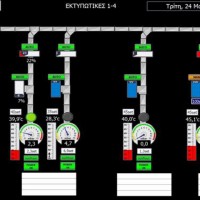Flexo printing machines are machines printing on plastic bags. In order for the ink of the printing cylinder put on the plastic bag to dry, hot air is required. In order to create hot air, printing machines use electrical resistances, the power of which varies from 30 up to 120KW, depending on the size of the flexo. Many industries operate even 6 printing machines, where the total power required for drying the ink may reach 500KW.
P & G Automation S.A. developed an innovative system that dries simultaneously all printing machines from a central air heater using biomass. This means huge power saving in relation to the price of kilowatt-hour. In many cases, depending on the installation, it may exceed €10,000 per month.
The system’s greatest advantage is the up to 30% increase in production, since there is no limitation of thermal energy for the drying. This means we can supply greater hot air quantity, even during winter, and thus achieve faster drying and, consequently, increase in speed and production.
From a central panel, we can set the desired temperature and pressure in each machine. The role of the system is to automatically set up the air heater and individual parts, in order to maintain the desired values.
The difficulty facing the system is that every channel of flexo (tunnel – inks) requires different temperature and pressure. So, from a heat source (air heater), the heat must be distributed and set up in different temperature levels, depending on the requirements. Also, different air pressure levels must be maintained.
The company, taking the system one step forward, applied for the fist time to a biomass heater the automatic combustion set up with oxygen sensor. As is well known, biomass does not have a steady calorific value and moisture levels and, in conjunction with the combustion method in the combustion unit (blockage of combustion air passage holes) requires constant correction of the air set up. Naturally, this procedure requires a qualified operator, and even in that case, the desired outcome is not always achieved. The desired outcome means accurate air-fuel mixing.
If we set up the exact quantity of air in relation to the current fuel quantity, this means we achieve the perfect combustion. Perfect combustion means absorbing the maximum thermal energy from the fuel with the least possible pollutants. This is achieved with automatic set up of air in relation to the fuel, with biomass consumption decrease up to 90%.
A weigher is also installed in the air heater silo, in order to check the remaining biomass. When levels go below a certain threshold, an audible warning (siren) is enabled, in order to inform us regarding biomass shortage.
Furthermore, we have developed a special algorithm that calculates current real biomass consumption in kilos per hour, average consumption and total consumption of kilos for a specified period.






